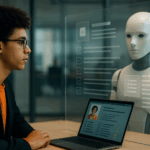A tap-and-go world is already here. What now?

If you have visited an advanced city in any country with high labour costs recently, you will have noticed a peculiar phenomenon, post-COVID. The digital acceleration in ordinary life is very, very real.
Supermarkets in those cities have very few people deployed to receive your payment. Self-checkout counters are the norm, where you scan your items yourself, pay without any assistance, and bag your own shopping.
Visit a bank branch, and see no tellers. There are machines and interfaces everywhere, and perhaps a person to show you how to use them—or better still, to show you how to do your banking on your phone, so that next time you don’t even come to the branch. The humans present are more like advisors and fixers, there to help you with the parts the tech doesn’t reach.
Wherever you go, tap-to-pay rules. Some people tap their credit or debit cards; others just tap their phones. In restaurants, retail outlets, train stations, buses—even the relatively minor friction of taking out your card and entering a PIN code is gone. You tap, and you go. Cash? What’s that?
Hungry? Take out your phone, choose some food, pay via Google or Apple, sit back. 30 or so minutes later, ding ding, your food has arrived.
I watched this new low-touch world taken to a new level at an Amazon Fresh store. I walked in, chose my groceries and some fresh fruits, put them into my basket, and then just walked out. No checkout, at all! And yet, I got an alert a minute later showing my receipt. It was all done with cameras and scanners, and used my existing Amazon account.
It’s all pretty dramatic and eye-popping. But is it a good thing?
For one thing, where did all those jobs go? All the checkout folks, the tellers, the packers, the till minders. Defunct and obsolete? What became of them? The smart theorists will tell you not to worry, the old jobs may be gone but new ones are being created all the time. We may not need people to record transactions or pack, but we do need them to code and design, to work with data, to manage digital journeys.
Uh huh, I get it. But what about those specific folks, who were just assistants and minders, packers and guards? The Amazon Fresh store I visited had just two employees. One to help people overcome their surprise and just open their app; and another to refresh and rearrange the shelves. Just two people were doing what was once done by ten or even twenty. Where did they all go? Back to school to learn new digital tricks? I don’t think so. Some people may be cashing in big because of this great hollowing out and the dramatic productivity gains; but many more are going to be blindsided and left stranded without income to take or contributions to make. Society has a huge problem building, and I fear we will have an ugly transition.
But wait, is the digital acceleration inevitable? No, there is a nuance not to be missed. I visited several shoe stores and found a dearth of assistants. You served yourself, or waited interminably to be served. I ended up leaving without buying. One store on the street was different, though. It had a large number of assistants, smiley and helpful, ready to chat and offer suggestions. I found what I wanted there, and bought a pair. Aha, I thought: someone gets it. Zig when everyone zags.
Indeed, some supermarkets are introducing a novel concept that’s very old: the slow checkout! They are putting in specific lanes for folks who want to do things the old-fashioned way, getting a lot of help and chatter as they check out. The assistants manning those counters are chosen for their helpful and talkative natures, not for their speed in using the tech. That makes a lot of sense in localities with a larger proportion of elderly people. Smart thinking.
Where is this going? Thoughtful businessfolk will neither embrace the new blindly nor reject it wholesale. Certainly, we all need to go digital. Contactless payments and low-friction customer journeys are resisted at your peril. But we also need to be smart enough to know our customers, young and old. It’s not binary. The wise will develop a two-track approach: low-touch and high-touch. Speed and convenience for some; hand-holding and human interaction for others; great customer experience for all. You do what works for your customers, not what works for you.
The deeper lesson comes back to my oft-repeated refrain: humanize as you digitize. All this technological acceleration is great, it really is. Why should we not have greater efficiency, greater speed, greater ease of use? Why should humans continue to do what humans no longer need to? But equally, intelligent change does not come from the tech alone; it comes from how humans interact with the tech. As jobs change and customers change, the sensible leader observes carefully and compassionately—and makes money from this discernment.
(Sunday Nation, 29 January 2023)

Buy Sunny Bindra's new book
The X in CX
here »
Popular Posts
- NY’s wake-up call to the old guardNovember 9, 2025
- How to listen, really listenNovember 16, 2025
- Save your strength for repairsNovember 2, 2025
- Here’s why you should become foolishNovember 30, 2025
- Is AI hiring your company into oblivion?November 23, 2025















